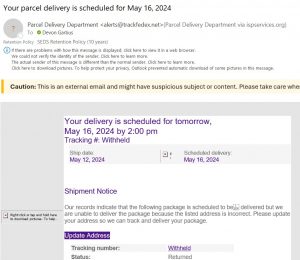
Sophisticated phishing attacks exhibit multiple layers, with malicious actors resorting to extensive measures to breach security barriers in pursuit of intellectual property, financial assets, and sensitive data. Every day there are new (and effective) complex phishing campaigns targeting corporations of all sizes (no one is too big or too small. Let’s shed light on the strategies, repercussions, and proactive steps to mitigate the associated risks.
This incident was initiated by a modestly sized general contractor. This company operated with a streamlined workforce and had minimal onsite IT support. This left them unprepared when a series of seemingly random emails were dispatched to different employees within the contracting firm, posing as official communications from Microsoft. These deceptive emails requested recipients to log in to a counterfeit Microsoft website to update their password credentials.
Regrettably, one of the employees, (let’s call her Pam), within the contracting company, fell victim to the phishing attempt and attempted to log in to the fraudulent Microsoft site. Upon realizing that nothing occurred after submitting her credentials on the counterfeit website, she dismissed it as a technical glitch and moved on. Unfortunately, this employee happened to work in the accounts receivable department.
With access to the worker's account credentials, the perpetrators infiltrated her account, where they meticulously copied all her data, encompassing both incoming and outgoing emails. Among this trove of information, they discovered numerous invoices that she had sent to various organizations within the local area.
Subsequently, the attackers took their scheme a step further by acquiring a new domain name designed to closely mimic the contractor's legitimate domain. The fraudulent domain name bore a striking resemblance, differing by just a single character – in this case, substituting one "I" with two. For instance, while the authentic domain was "StarkIndustries.com," they secured "StarkIndustriies.com." They then proceeded to establish an offshore email account under the guise of the compromised worker, adopting an email address like "Pam@StarkIndustriies.com." Furthermore, they orchestrated the opening of a bank account at a local financial institution using entirely fabricated information.
Subsequently, the attackers initiated the second phase of their operation. Armed with a wealth of data obtained from Pam, they gained access to numerous unpaid invoices owed to the contracting company. They then manipulated the legitimate email communication by forwarding it to the email address they had set up, "Pam@StarkIndustriies.com." While impersonating Pam, they informed the clients that the outstanding payments were still pending. Notably, they slyly introduced a deceptive twist, notifying the clients that the company had recently updated its banking information and requested the funds be deposited electronically into a new digital bank address.
Regrettably, at this juncture, two organizations became victims of this scheme and remitted payments for invoices totaling over two hundred thousand dollars to the fraudulent bank address. Astonishingly, these financial transactions went undetected for more than two weeks. The contracting company, oblivious to the unfolding events, remained dark about the situation. Only when one of the two organizations, who had settled the dues with the sham company, reached out to inform them about the overdue balance that the real Pam was alerted to the situation. This revelation transpired when one affected company disclosed that they had already paid using the new bank account information.
Upon the revelation of the breach, the IT security team swiftly sprang into action, promptly recognizing the phishing attack and initiating the incident response protocol. As their first step, they revoked access to the compromised account and launched an in-depth investigation.
In parallel, the team initiated a comprehensive Security Awareness Training program for all employees and contractors within the organization. Simultaneously, they introduced an immediate rollout of a Multi-Factor Authentication (MFA) system for all individuals accessing the organization's systems while enabling MFA checks for all Microsoft-related applications.
Additionally, the organization invested substantially in advanced cybersecurity tools and solutions to proactively identify and thwart phishing attacks and other security threats, explicitly targeting email spoofing and impersonation scams.
Phishing attacks are an ongoing and grave concern for organizations and individuals worldwide. IT and Business leaders of 2024 need to stay vigilant, providing employees with the proper training, and fortifying cybersecurity measures to fend off such threats. Proper training, rapid incident response, and proper monitoring and alerting would have saved this company tons of grief, and money.


